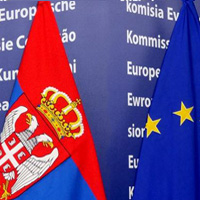Hotline: +381 61 63 84 071
National legal framework
 Foundation for institutional addressing of the issue of human trafficking and, in this regard, the establishment and operation of the National mechanism for identification, assistance and protection of victims in the Republic of Serbia, consist of several laws and numerous subordinate legislation, several national strategies and action plans.
Foundation for institutional addressing of the issue of human trafficking and, in this regard, the establishment and operation of the National mechanism for identification, assistance and protection of victims in the Republic of Serbia, consist of several laws and numerous subordinate legislation, several national strategies and action plans.
The most important law in this area is the Criminal Code of the Republic of Serbia from 2003. which brings the legal description of the offence of human trafficking (Article 388), and also stipulates a penalty for this act. The main text of the law later underwent certain changes, so that, for example, the minimum sentence for carrying out the basic form of this offence increased from two to three years, or five if the victim was a minor. The law clearly describes and lists the actions that are to be considered the crime of human trafficking, and then states the goals for which they apply, and types of exploitation arising from these actions. The Criminal Code also determines the penalties for persons who knew or could have known about the implementation of the actions of this crime, and its criminalization is not affected by the possible consent of the victim to be exploited.
The Law on Juvenile Offenders and Criminal Protection of Juveniles, among other things, contains provisions regarding the protection of juveniles when they are in the role of the injured party in a criminal proceeding. These provisions relate to the protection in court proceedings when the juvenile was a victim of human trafficking, and that protection is reflected in specific rules during the conduct of the proceedings. In this regard, judges, investigating judges, the heads of panels, public prosecutors and specialized police officers involved in a trial where the victim is a juvenile, must possess the necessary knowledge in the field of child rights and criminal protection of juveniles, and the same provision applies to the authorized representative of the victim.
According to the Law on Foreigners, persons who are foreign citizens, and are victims of human trafficking, will be granted a temporary stay in the territory of the Republic of Serbia (from 90 days up to one year), and, if necessary, the means of subsistence. However, this type of protection is still conditional, since the law assumes legitimate interests in the conduct of criminal proceedings against the perpetrators of the crime of human trafficking, and then enables this protection, and the victims are to be denied temporary residence permit if it is required by the interest of preserving public order.
Certain provisions of the Law on Asylum, also refer and apply to cases of human trafficking. This law provides protection from re-victimization and can, in this respect, incriminate possible expulsion or involuntary return of persons to a territory where their life or freedom would be threatened on the account of personal characteristics or attitudes, so in that sense, the law provides protection from re-trafficking. The provisions on the prohibition of expulsion are not related to persons who are reasonably suspected of threatening national security.
In addition to these laws, certain provisions on the treatment of the crime of human trafficking, protection and assistance to victims, and conducting court proceedings, can also be found in the Law on Administrative Taxes and Fees Act, the Health Care Law, the Law on Ratification of the Council of Europe Convention on action against trafficking in human beings as well as in the Law on Ratification of the Council of Europe Convention on the Protection of Children against Sexual Exploitation and Sexual Abuse.
When it comes to subordinate legislation relevant to this issue, it is necessary to mention the Guidelines on the implementation of the Law on Foreigners, which, among other things, specifies basis and duration of stay of foreigners for humanitarian reasons, and contains a particularly important clause of good conduct of illegal entry into the territory of the Republic of Serbia for the persons who are victims of human trafficking. There are also Instructions on the work of Agency for Coordination of Protection of Victims of Human Trafficking, which specifies duties and responsibilities of the Agency, as well as the Agreement on Cooperation between the Ministries of the Interior, Finance, Justice, Health, Education, Labour and Social Policy in the fight against human trafficking, which assumes the establishment of the National Mechanism for the common and continual struggle of these ministries against human trafficking, and for the protection of its victims.
As for other legal documents, at the national level, that deal with the issue of human trafficking, it is necessary to emphasize the importance of a number of strategies and accompanying action plans. The Strategy to combat human trafficking from 2006. lists a number of levels on which we must act in order to achieve the desired goals: institutional framework, prevention, assistance, protection and reintegration of victims, international cooperation and monitoring and evaluation of results. National Action Plan for Combating Trafficking in Human Beings for the period from 2009. to 2011. lists and analyses different goals, such as raising awareness about the issue of human trafficking, reducing risk factors, improving the identification of victims. Matters within the scope of the fight against human trafficking are also being dealt with by Migration Management Strategy, Strategy for Combating Illegal Migration in the Republic of Serbia for the period from 2009. to 2014, Integrated Border Management Strategy, National Strategy for the prevention and protection of children from violence and the accompanying Action Plan for its implementation, then the National Strategy for the Advancement of Women and Promoting Gender Equality with its Action Plan for its implementation, and finally the Strategy for the improvement of the status of Roma in the Republic of Serbia and the Action plan for its implementation.












 FACEBOOK
FACEBOOK TWITTER
TWITTER YOUTUBE
YOUTUBE